Annual and Seasonal Glacier-Wide Surface Mass Balance Quantified from Changes in Glacier Surface State: A Review on Existing Methods Using Optical Satellite Imagery
Abstract
:1. Introduction
2. Methods to Retrieve Annual and Seasonal Glacier-Wide Surface Mass Balances Using Optical Satellite Imagery
2.1. The ELA method
2.1.1. Principles and History of the Method
- Two DEMs covering the entire region of interest (RoI); one at (or close to) the beginning of the study period, one at (or close to) the end.
- One cloud-free satellite image for each glacier under study and for each year of the study period. In temperate latitudes, the image must have been acquired at the end of the summer season and, in the outer tropics, during the dry season.
- An estimate of the mass-balance gradient in the vicinity of the ELA.
2.1.2. Application of the Method on 30 Glaciers in the French Alps
2.2. The Albedo Method
2.2.1. Principles and History of the Method
2.2.2. Application of the Albedo Method on New Zealand Southern Alps Glaciers
2.3. The Snow-Map Method
2.3.1. Principles and History of the Method
- Several optical satellite images for each season of the studied period, covering the region of interest (ROI).
- One DEM of the ROI acquired during the studied period.
- Observed seasonal SMB available over the studied period covered by the satellite (or for sub-period of the study period).
2.3.2. Application of the Method on 55 Glaciers in the European Alps
3. Discussion
3.1. Limits of the Methods
3.1.1. Cloud Cover
3.1.2. Glacier Size and Elevation
3.1.3. Debris-Covered Glaciers
3.1.4. Polar and Monsoon-Regime Glaciers
3.1.5. Spatial Distribution of Surface Mass Balance
3.2. Future Challenges
3.2.1. Automating the Data Processing
3.2.2. Use of Other Images
3.2.3. Generalization of the Calibrated Methods
4. Conclusions
Acknowledgments
Author Contributions
Conflicts of Interest
References
- GCOS Essential Climate Variables. Available online: http://www.wmo.int/pages/prog/gcos/index.php?name=EssentialClimateVariables (accessed on 8 November 2016).
- Zemp, M.; Frey, H.; Gärtner-Roer, I.; Nussbaumer, S.U.; Hoelzle, M.; Paul, F.; Haeberli, W.; Denzinger, F.; Ahlstrøm, A.P.; Anderson, B. Historically unprecedented global glacier decline in the early 21st century. J. Glaciol. 2015, 61, 745–762. [Google Scholar] [CrossRef]
- Pfeffer, W.T.; Arendt, A.; Bliss, A.; Bolch, T.; Cogley, J.G.; Gardner, A.; Hagen, J.O.; Hock, R.; Kaser, G.; Kienholz, C.; et al. The Randolph Glacier Inventory: A globally complete inventory of glaciers. J. Glaciol. 2014, 60, 537–552. [Google Scholar] [CrossRef]
- GLIMS Website. Available online: http://www.glims.org/ (accessed on 8 November 2016).
- Rees, W.G. Remote Sensing of Snow and Ice; CRC Press: Boca Raton, FL, USA, 2005; p. 285. [Google Scholar]
- Berthier, E.; Vincent, C.; Magnússon, E.; Gunnlaugsson, Á.Þ.; Pitte, P.; Le Meur, E.; Masiokas, M.; Ruiz, L.; Pálsson, F.; Belart, J.M.C.; et al. Glacier topography and elevation changes derived from Pléiades sub-meter stereo images. Cryosphere 2014, 8, 2275–2291. [Google Scholar] [CrossRef]
- Shean, D.E.; Alexandrov, O.; Moratto, Z.; Smith, B.E.; Joughin, I.R.; Porter, C.C.; Morin, P.J. An automated, open-source pipeline for mass production of digital elevation models (DEMs) from very high-resolution commercial stereo satellite imagery. ISPRS J. Photogramm. Remote Sens. 2016, 116, 101–117. [Google Scholar] [CrossRef]
- Greuell, W.; Kohler, J.; Obleitner, F.; Glowacki, P.; Melvold, K.; Bernsen, E.; Oerlemans, J. Assessment of interannual variations in the surface mass balance of 18 Svalbard glaciers from the Moderate Resolution Imaging Spectroradiometer/Terra albedo product. J. Geophys. Res. 2007, 112, D07105. [Google Scholar] [CrossRef]
- Rabatel, A.; Dedieu, J.-P.; Vincent, C. Spatio-temporal changes in glacier-wide mass balance quantified by optical remote-sensing on 30 glaciers in the French Alps for the period 1983–2014. J. Glaciol. 2016, 62, 1153–1166. [Google Scholar] [CrossRef]
- Cogley, J.G.; Hock, R.; Rasmussen, L.A.; Arendt, A.A.; Bauder, A.; Braithwaite, R.J.; Jansson, P.; Kaser, G.; Möller, M.; Nicholson, L.; et al. Glossary of Glacier Mass Balance and Related Terms; IHP-VII Technical Documents in Hydrology No. 86; IACS Contribution No. 2; UNESCO: Paris, France, 2011; p. 114. [Google Scholar]
- Lliboutry, L. Traité de Glaciologie; Tome II: Glaciers, Variations du Climat, Sols Gelés; Masson et Cie: Paris, France, 1965; p. 616. [Google Scholar]
- Braithwaite, R.J. Can the mass balance of a glacier be estimated from its equilibrium-line altitude? J. Glaciol. 1984, 30, 364–368. [Google Scholar] [CrossRef]
- Rabatel, A.; Dedieu, J.-P.; Vincent, C. Using remote-sensing data to determine equilibrium-line altitude and mass-balance time series: Validation on three French glaciers, 1994–2002. J. Glaciol. 2005, 51, 539–546. [Google Scholar] [CrossRef]
- Pelto, M.; Kavanaugh, J.; McNeil, C. Juneau Icefield Mass Balance Program 1946–2011. Earth Syst. Sci. Data 2013, 5, 319–330. [Google Scholar] [CrossRef]
- La Chapelle, E.R. Assessing glacier mass budgets by reconnaissance aerial photography. J. Glaciol. 1962, 4, 290–297. [Google Scholar] [CrossRef]
- Meier, M.F.; Post, A.S. Recent Variations in Mass Net Budgets of Glaciers in Western North America. In Symposium ofObergurgl; Publication 58 of the IAHS; IASH: Gentbrugge, Belgium, 1962; pp. 63–77. [Google Scholar]
- Østrem, G. ERTS data in glaciology—An effort to monitor glacier mass balance from satellite imagery. J. Glaciol. 1975, 15, 403–415. [Google Scholar] [CrossRef]
- Dedieu, J.P.; Reynaud, L.; Sergent, C. Apport des données SPOT et Landsat TM pour le suivi de la fusion nivale et des bilans glaciaires dans les Alpes françaises. Soc. Fr. Photogramm. Télédétec. 1989, 115, 49–52. [Google Scholar]
- Rabatel, A.; Dedieu, J.-P.; Reynaud, L. Reconstitution des fluctuations du bilan de masse du Glacier Blanc (Massif des Ecrins, France) par télédétection optique (imagerie Spot et Landsat). Houille Blanche 2002, 6–7, 64–71. [Google Scholar] [CrossRef]
- Rabatel, A.; Dedieu, J.-P.; Thibert, E.; Letréguilly, A.; Vincent, C. 25 years (1981–2005) of equilibrium-line altitude and mass-balance reconstruction on Glacier Blanc, French Alps, using remote-sensing methods and meteorological data. J. Glaciol. 2008, 54, 307–314. [Google Scholar] [CrossRef]
- Rabatel, A.; Bermejo, A.; Loarte, E.; Soruco, A.; Gomez, J.; Leonardini, G.; Vincent, C.; Sicart, J.-E. Can the snowline be used as an indicator of the equilibrium line and mass balance for glaciers in the outer tropics? J. Glaciol. 2012, 58, 1027–1036. [Google Scholar] [CrossRef]
- Chinn, T.J.; Heydenrych, C.; Salinger, J. Use of the ELA as a practical method of monitoring glacier response to climate in New Zealand’s Southern Alps. J. Glaciol. 2005, 51, 85–96. [Google Scholar] [CrossRef]
- Mernild, S.; Pelto, M.; Malmros, J.; Yde, J.; Knudsen, N.; Hanna, E. Identification of snow ablation rate, ELA, AAR and net mass balance using transient snow line variations on two Arctic glaciers. J. Glaciol. 2013, 59, 649–659. [Google Scholar] [CrossRef]
- Shea, J.M.; Menounos, B.; Moore, R.D.; Tennant, C. An approach to derive regional snow lines and glacier mass change from MODIS imagery, western North America. Cryosphere 2013, 7, 667–680. [Google Scholar] [CrossRef]
- Tawde, S.A.; Kulkarni, A.V.; Bala, G. Estimation of glacier mass balance on a basin scale: An approach based on satellite-derived snow lines and a temperature index model. Curr. Sci. 2017, 111, 1977–1989. [Google Scholar] [CrossRef]
- Vincent, C.; Fischer, A.; Mayer, C.; Bauder, A.; Galos, A.P.; Funk, M.; Thibert, E.; Six, D.; Braun, L.; Huss, M. Common climatic signal from glaciers in the European Alps over the last 50 years. Geophys. Res. Lett. 2017, 44. [Google Scholar] [CrossRef]
- World Glacier Monitoring Service. Global Glacier Change Bulletin No. 1 (2012–2013); Zemp, M., Gärtner-Roer, I., Nussbaumer, S.U., Hüsler, F., Machguth, H., Mölg, N., Paul, F., Hoelzle, M., Eds.; ICSU(WDS)/IUGG(IACS)/ UNEP/UNESCO/WMO, World Glacier Monitoring Service: Zurich, Switzerland, 2015; p. 230. [Google Scholar]
- Sicart, J.E.; Hock, R.; Six, D. Glacier melt, air temperature, and energy balance in different climates: The Bolivian Tropics, the French Alps, and northern Sweden. J. Geophys. Res. 2008, 113, D24113. [Google Scholar] [CrossRef]
- Oerlemans, J.; Giesen, R.H.; Van den Broeke, M.R. Retreating alpine glaciers: Increased melt rates due to accumulation of dust (Vadret da Morteratsch, Switzerland). J. Glaciol. 2009, 55, 729–736. [Google Scholar] [CrossRef]
- Six, D.; Wagnon, P.; Sicart, J.E.; Vincent, C. Meteorological controls on snow and ice ablation for two contrasting months on Glacier de Saint-Sorlin, France. Ann. Glaciol. 2009, 50, 66–72. [Google Scholar] [CrossRef]
- Cullen, N.J.; Conway, J.P. A 22 month record of surface meteorology and energy balance from the ablation zone of Brewster Glacier, New Zealand. J. Glaciol. 2015, 61, 931–946. [Google Scholar] [CrossRef]
- De Ruyter de Wildt, M.S.; Oerlemans, J.; Björnsson, H. A method for monitoring glacier mass balance using satellite albedo measurements: Application to Vatnajökull, Iceland. J. Glaciol. 2002, 48, 267–278. [Google Scholar] [CrossRef]
- Greuell, W.; Oerlemans, J. Assessment of the surface mass balance along the K-transect (Greenland ice sheet) from satellite-derived albedos. Ann. Glaciol. 2005, 42, 107–117. [Google Scholar] [CrossRef]
- Dumont, M.; Gardelle, J.; Sirguey, P.; Guillot, A.; Six, D.; Rabatel, A.; Arnaud, Y. Linking glacier annual mass balance and glacier albedo retrieved from MODIS data. Cryosphere 2012, 6, 1527–1539. [Google Scholar] [CrossRef]
- Sirguey, P.; Mathieu, R.; Arnaud, Y. Subpixel monitoring of the seasonal snow cover with MODIS at 250~m spatial resolution in the Southern Alps of New Zealand: Methodology and accuracy assessment. Remote Sens. Environ. 2009, 113, 160–181. [Google Scholar] [CrossRef]
- Dumont, M.; Sirguey, P.; Arnaud, Y.; Six, D. Monitoring spatial and temporal variations of surface albedo on Saint Sorlin Glacier (French Alps) using terrestrial photography. Cryosphere 2011, 5, 759–771. [Google Scholar] [CrossRef]
- Dyurgerov, M.; Meier, M.F.; Bahr, D.B. A new index of glacier area change: A tool for glacier monitoring. J. Glaciol. 2009, 55, 710–716. [Google Scholar] [CrossRef]
- Cullen, N.; Anderson, B.; Sirguey, P.; Stumm, D.; Mackintosh, A.; Conway, J.P.; Horgan, H.J.; Dadic, R.; Fitzsimons, S.J.; Lorrey, A. An eleven-year record of mass balance of Brewster Glacier, New Zealand, determined using a geostatistical approach. J. Glaciol. 2016. [Google Scholar] [CrossRef]
- Wang, J.; Ye, B.; Cui, Y.; He, X.; Yang, G. Spatial and temporal variations of albedo on nine glaciers in western China from 2000 to 2011. Hydrol. Process. 2013, 28, 3454–3465. [Google Scholar] [CrossRef]
- Brun, F.; Dumont, M.; Wagnon, P.; Berthier, E.; Azam, M.F.; Shea, J.M.; Sirguey, P.; Rabatel, A.; Ramanathan, A. Seasonal changes in surface albedo of Himalayan glaciers from MODIS data and links with the annual mass balance. Cryosphere 2015, 9, 341–355. [Google Scholar] [CrossRef]
- Colgan, W.; Box, J.E.; Fausto, R.S.; van As, D.; Barletta, V.R.; Forsberg, R. Surface albedo as a proxy for the mass balance of Greenland’s terrestrial ice. Geol. Surv. Den. Greenl. Bull. 2014, 31, 91–94. [Google Scholar]
- Sirguey, P.; Still, H.; Cullen, N.J.; Dumont, M.; Arnaud, Y.; Conway, J.P. Reconstructing the mass balance of Brewster Glacier, New Zealand, using MODIS-derived glacier-wide albedo. Cryosphere 2016, 10, 2465–2484. [Google Scholar] [CrossRef]
- Chinn, T.J.; Fitzharris, B.; Willsman, A.; Salinger, M. Annual ice volume changes 1976–2008 for the New Zealand Southern Alps. Glob. Planet Chang. 2012, 92–93, 105–118. [Google Scholar] [CrossRef]
- Six, D.; Vincent, C. Sensitivity of mass balance and equilibrium-line altitude to climate change in the French Alps. J. Glaciol. 2014, 60, 867–878. [Google Scholar] [CrossRef]
- Crane, R.G.; Anderson, M. Satellite discrimination of snow/cloud surfaces. Int. J. Remote Sens. 1984, 5, 213–223. [Google Scholar] [CrossRef]
- Dozier, J. Spectral signature of alpine snow cover from the Landsat Thematic Mapper. Remote Sens. Environ. 1989, 28, 9–22. [Google Scholar] [CrossRef]
- Fortin, J.; Bernier, M.; Battay, A.; Gauthier, Y.; Turcotte, R. Estimation of surface variables at the sub-pixel level for use as input to climate and hydrological models. In Proceedings of the Vegetation 2000 Conference, Belgirate, Italy, 3–6 April 2000; Volume 1. Available online: http://www.spot-vegetation.com/pages/vgtprep/vgt2000/fortin.html (accessed on 9 February 2015).
- Hall, D.K.; Riggs, G.A.; Salomonson, V.V.; DiGirolamo, N.E.; Bayr, K.J. MODIS snow-cover products. Remote Sens. Environ. 2002, 83, 181–194. [Google Scholar] [CrossRef]
- Salomonson, V.V.; Appel, I. Estimating fractional snow cover from MODIS using the normalized difference snow index. Remote Sens. Environ. 2004, 89, 351–360. [Google Scholar] [CrossRef]
- Chaponnière, A.; Maisongrande, P.; Duchemin, B.; Hanich, L.; Boulet, G.; Escadafal, R.; Elouaddat, S. A combined high and low spatial resolution approach for mapping snow covered areas in the Atlas mountains. Int. J. Remote Sens. 2005, 26, 2755–2777. [Google Scholar] [CrossRef]
- Drolon, V.; Maisongrande, P.; Berthier, E.; Swinnen, E.; Huss, M. Monitoring of seasonal glacier mass balance over the European Alps using low-resolution optical satellite images. J. Glaciol. 2016, 62, 912–927. [Google Scholar] [CrossRef]
- Demuth, M.N.; Pietroniro, A. Inferring glacier mass balance using RADARSAT: Results from Peyto Glacier, Canada. Geogr. Ann. 1999, 81A, 521–540. [Google Scholar] [CrossRef]
- Callegari, M.; Carturan, L.; Marin, C.; Notarnicola, P.; Rasner, P.; Seppi, R.; Zucca, F. A Pol-SAR analysis for alpine glaciers classification and snowline altitude retrieval. IEEE J. Sel. Top. Appl. Earth Obs. Remote Sens. 2016, 9, 3106–3121. [Google Scholar] [CrossRef]
- Benn, D.; Bolch, T.; Hands, K.; Gulley, J.; Luckman, A.; Nicholson, L.I.; Quincey, D.J.; Thompson, S.; Toumi, R.; Wiseman, S. Response of debris-covered glaciers in the Mount Everest region to recent warming, and implications for outburst flood hazards. Earth Sci. Rev. 2012, 114, 156–174. [Google Scholar] [CrossRef]
- Vincent, C.; Wagnon, P.; Shea, J.M.; Immerzeel, W.W.; Kraaijenbrink, P.; Shrestha, D.; Soruco, A.; Arnaud, Y.; Brun, F.; Berthier, E.; Sherpa, S.F. Reduced melt on debris-covered glaciers: Investigations from Changri Nup Glacier, Nepal. Cryosphere 2016, 10, 1845–1858. [Google Scholar] [CrossRef]
- Basantes Serrano, R.; Rabatel, A.; Francou, B.; Vincent, C.; Maisincho, L.; Cáceres, B.; Galarraga, R.; Alvarez, D. Slight mass loss revealed by reanalyzing glacier mass balance observations on Glaciar Antisana 15 during the 1995–2012 period. J. Glaciol. 2016, 62, 124–136. [Google Scholar] [CrossRef]
- Pelto, M. Utility of late summer transient snowline migration rate on Taku Glacier, Alaska. Cryosphere 2011, 5, 1127–1133. [Google Scholar] [CrossRef]
- Spiess, M.; Maussion, F.; Möller, M.; Scherer, D.; Schneider, C. MODIS derived equilibrium line altitude estimates for Purogangri ice cap, Tibetan Plateau, and their relation to climatic predictors (2001–2012). Geogr. Ann. 2015. [Google Scholar] [CrossRef]
- Drolon, V. Suivi du Bilan de Masse Saisonnier des Glaciers Alpins Grâce aux Images Satellites Optiques Basse Résolution. Ph.D. Thesis, University Paul Sabatier, Toulouse, France, 2016. [Google Scholar]

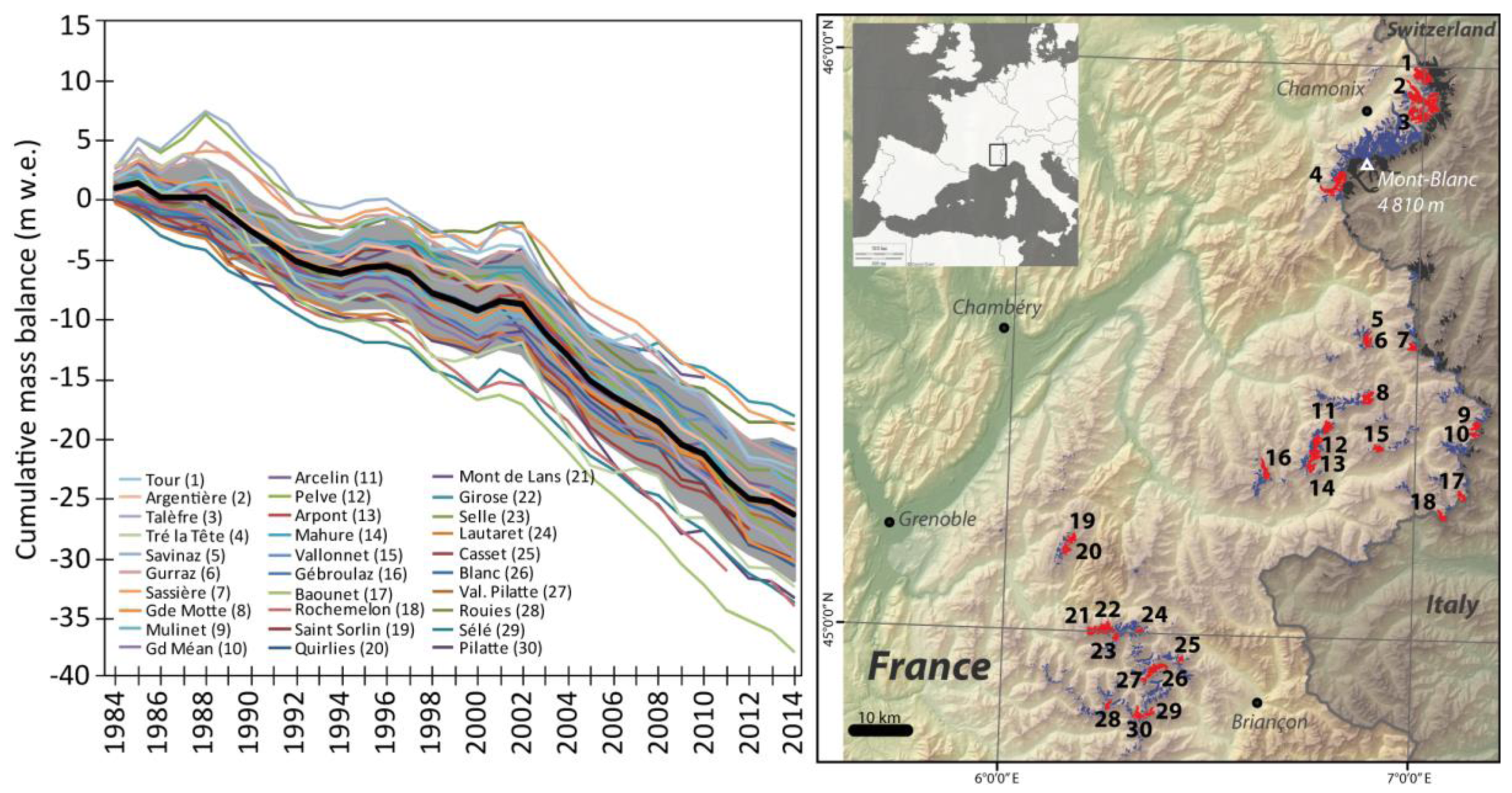
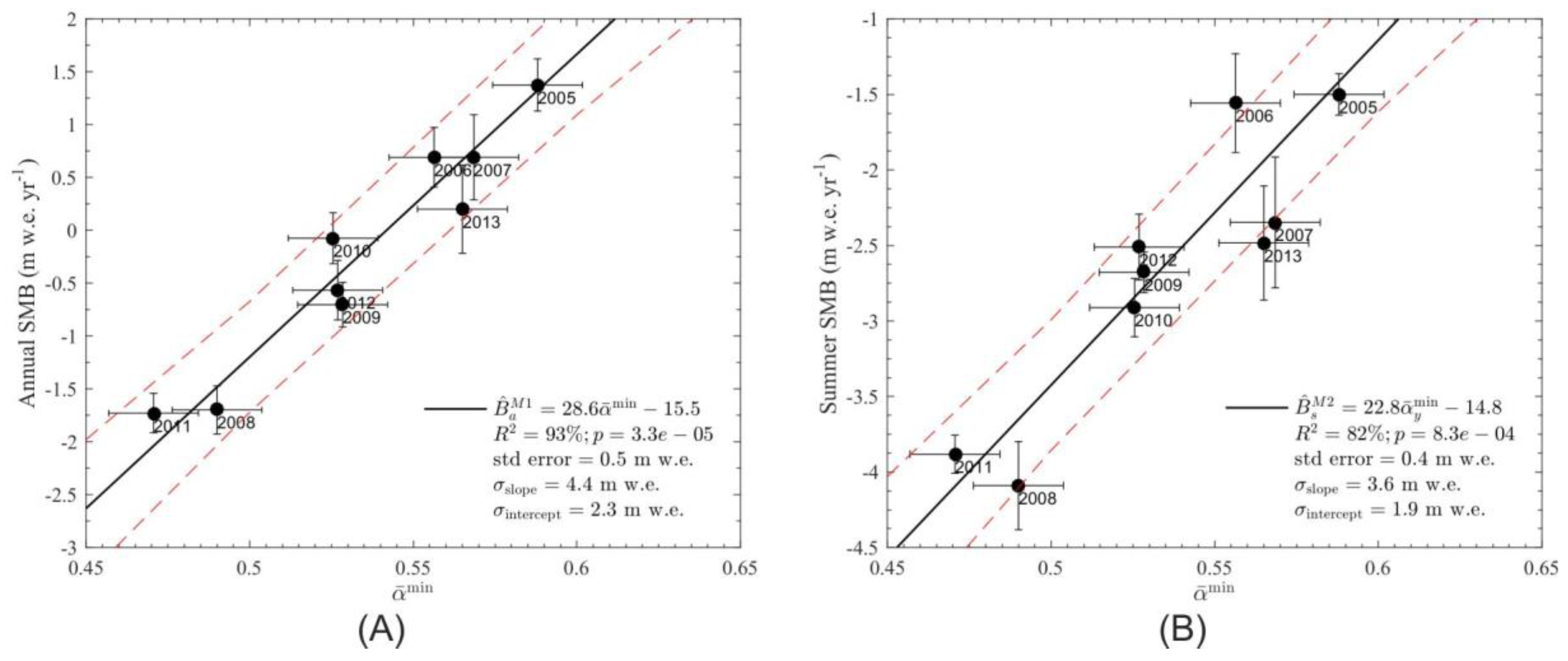
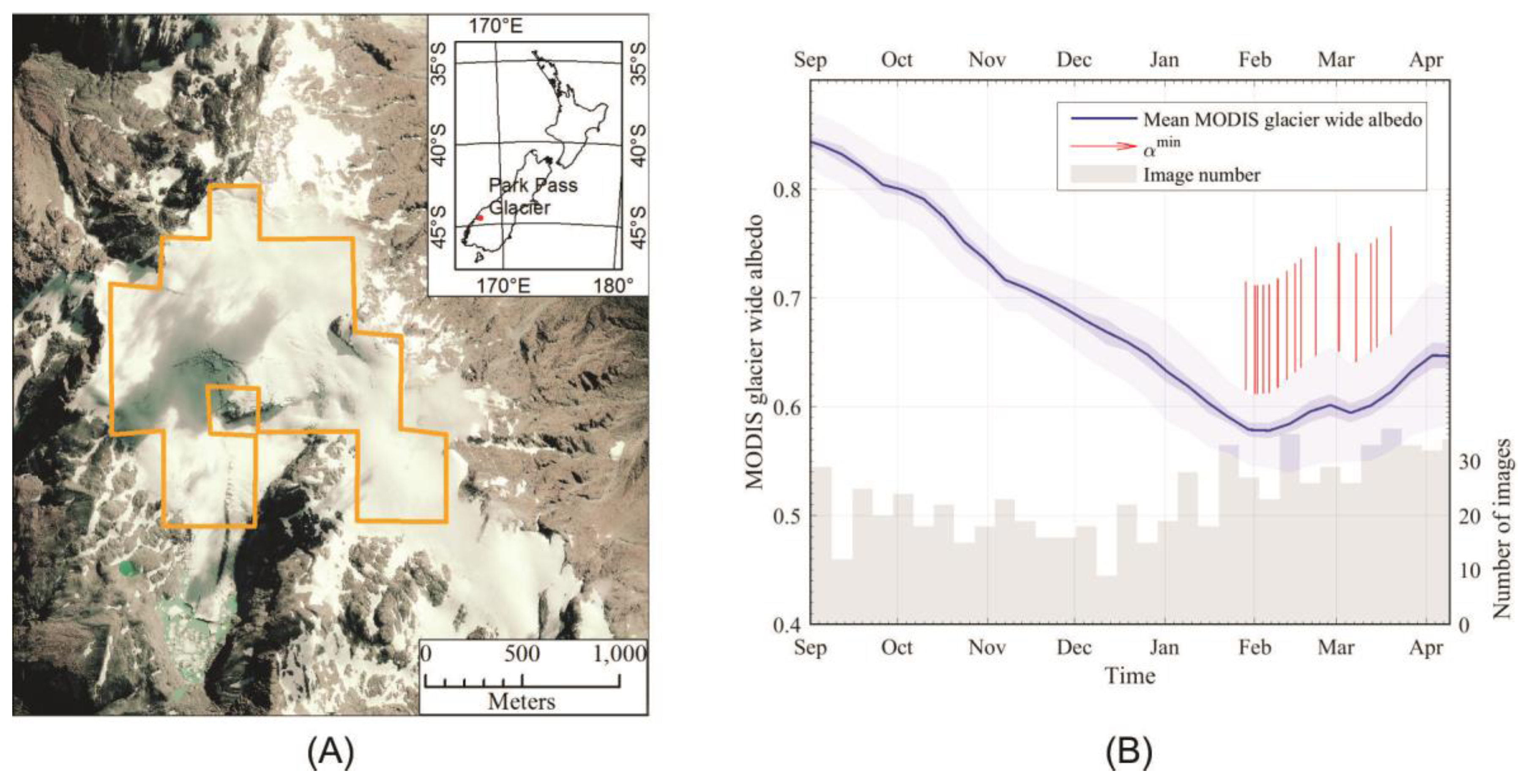

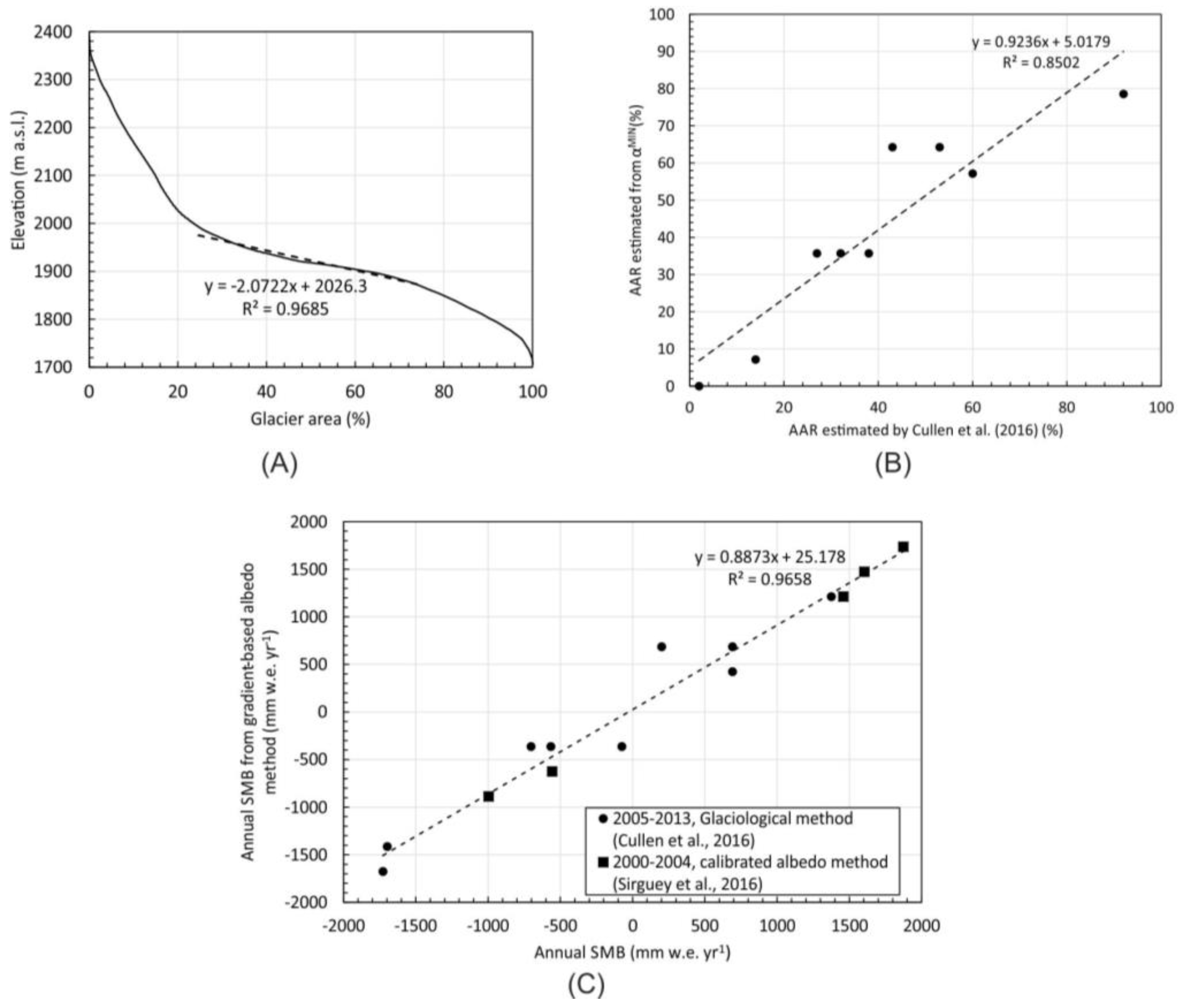
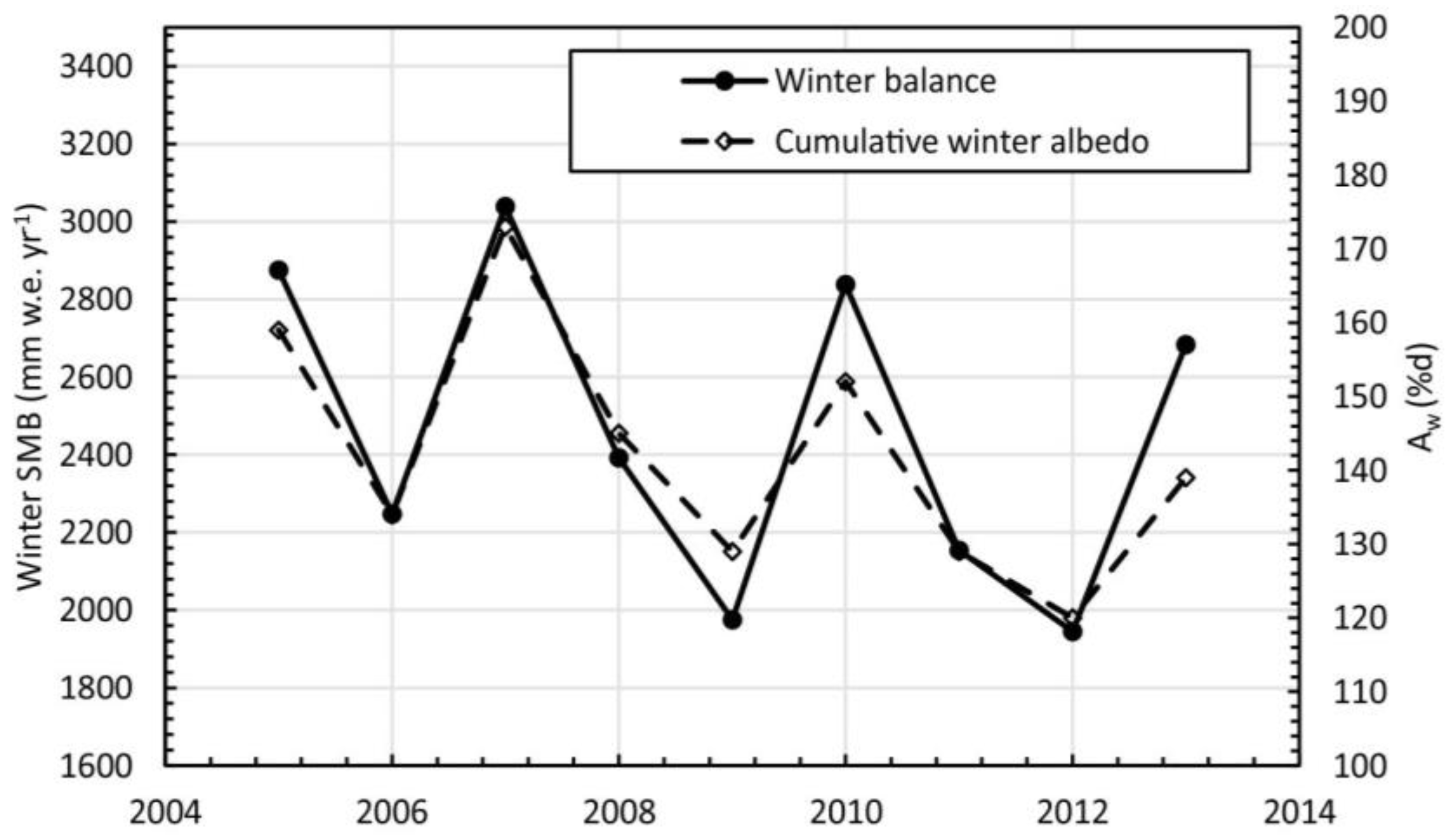
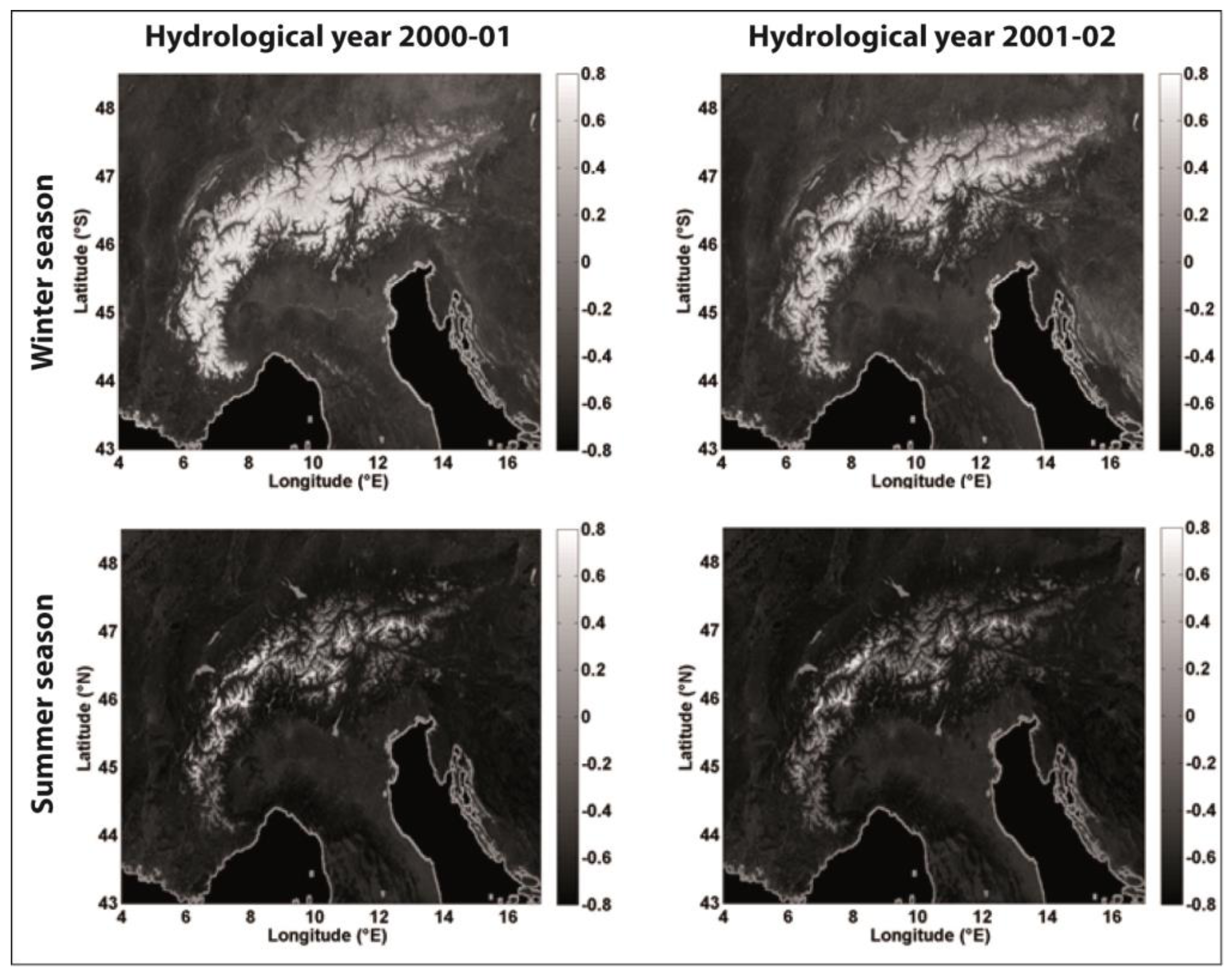
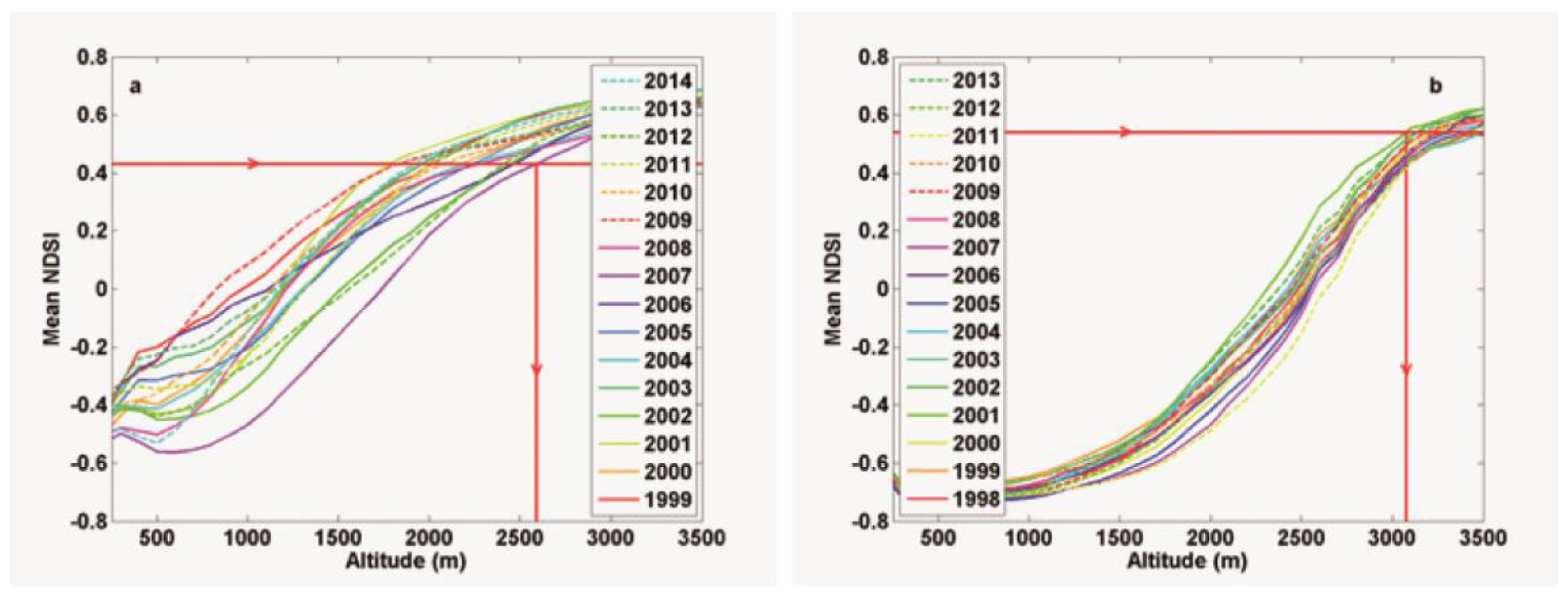

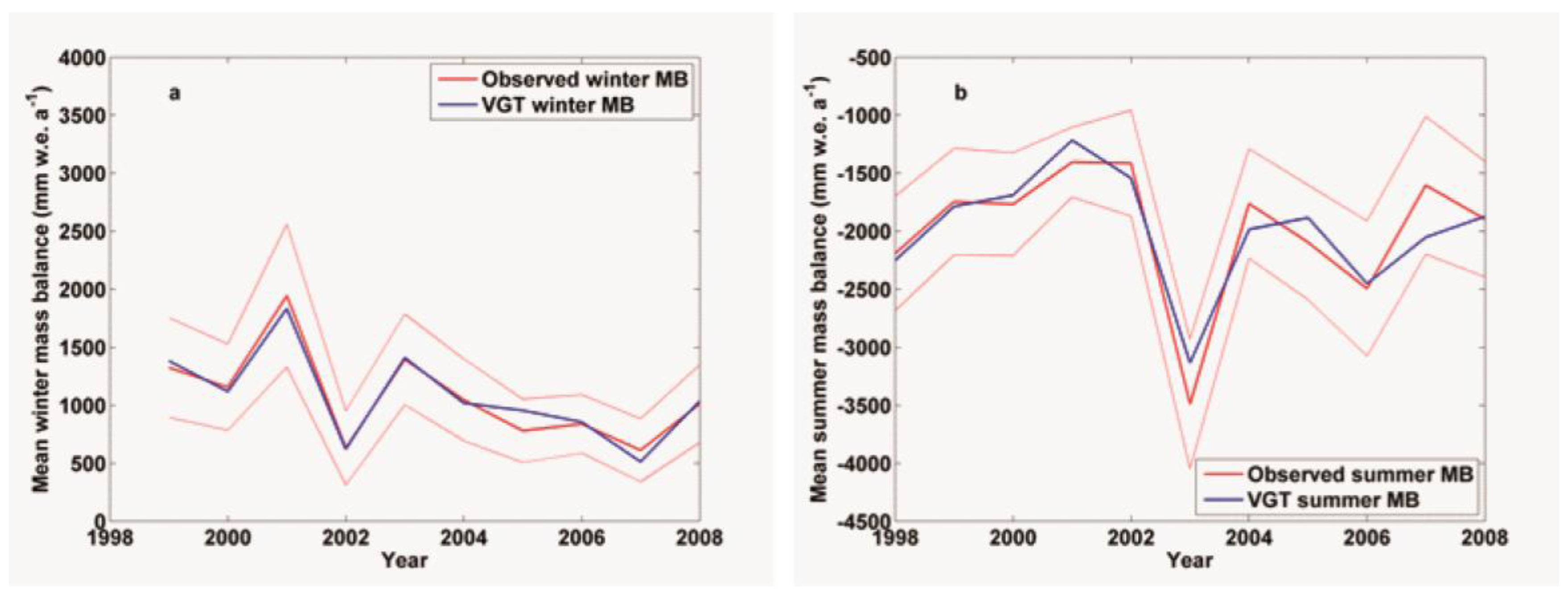
© 2017 by the authors. Licensee MDPI, Basel, Switzerland. This article is an open access article distributed under the terms and conditions of the Creative Commons Attribution (CC BY) license (http://creativecommons.org/licenses/by/4.0/).
Share and Cite
Rabatel, A.; Sirguey, P.; Drolon, V.; Maisongrande, P.; Arnaud, Y.; Berthier, E.; Davaze, L.; Dedieu, J.-P.; Dumont, M. Annual and Seasonal Glacier-Wide Surface Mass Balance Quantified from Changes in Glacier Surface State: A Review on Existing Methods Using Optical Satellite Imagery. Remote Sens. 2017, 9, 507. https://doi.org/10.3390/rs9050507
Rabatel A, Sirguey P, Drolon V, Maisongrande P, Arnaud Y, Berthier E, Davaze L, Dedieu J-P, Dumont M. Annual and Seasonal Glacier-Wide Surface Mass Balance Quantified from Changes in Glacier Surface State: A Review on Existing Methods Using Optical Satellite Imagery. Remote Sensing. 2017; 9(5):507. https://doi.org/10.3390/rs9050507
Chicago/Turabian StyleRabatel, Antoine, Pascal Sirguey, Vanessa Drolon, Philippe Maisongrande, Yves Arnaud, Etienne Berthier, Lucas Davaze, Jean-Pierre Dedieu, and Marie Dumont. 2017. "Annual and Seasonal Glacier-Wide Surface Mass Balance Quantified from Changes in Glacier Surface State: A Review on Existing Methods Using Optical Satellite Imagery" Remote Sensing 9, no. 5: 507. https://doi.org/10.3390/rs9050507





